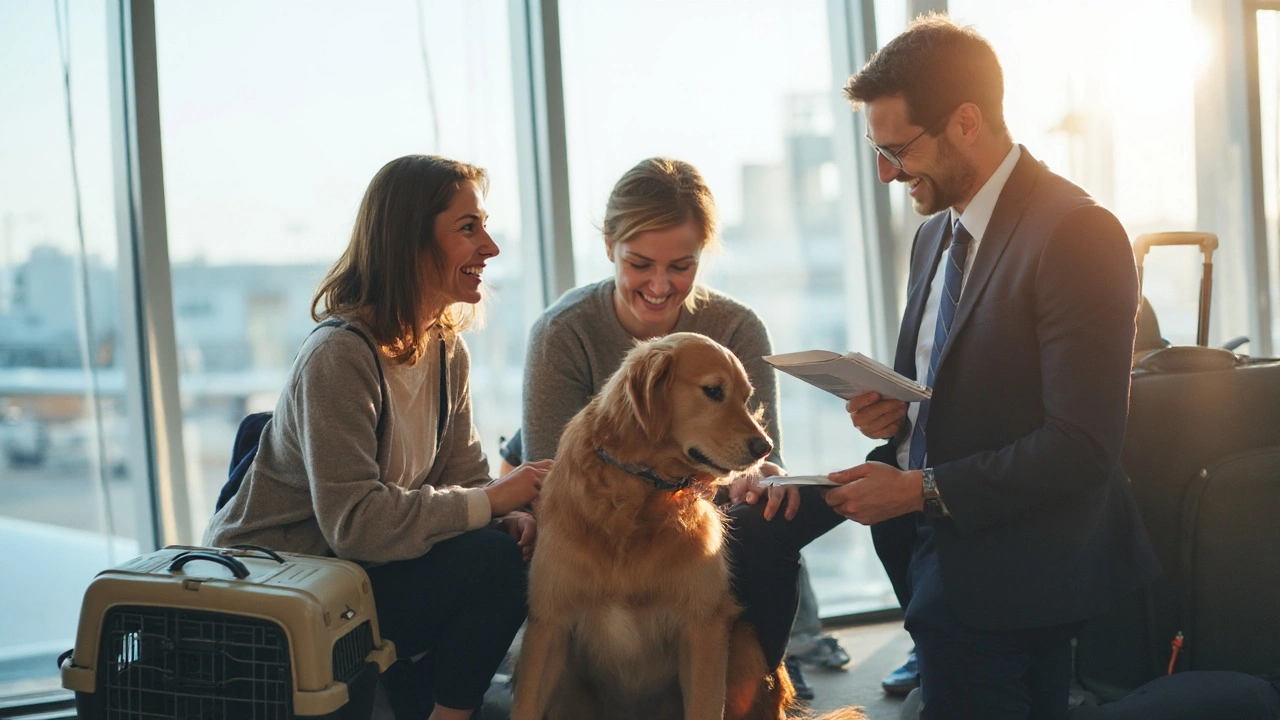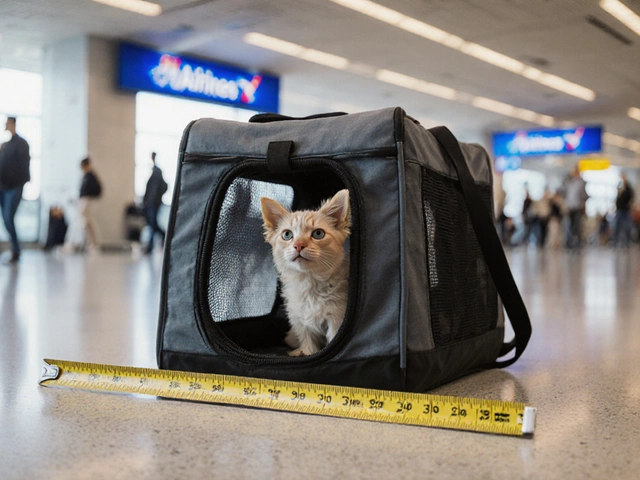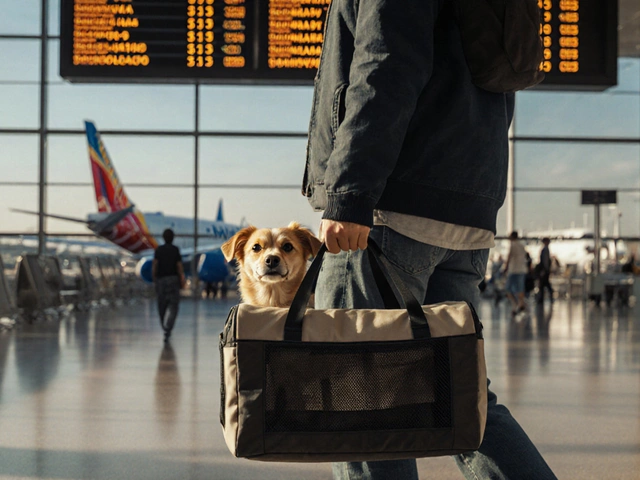Ever read a horror story about a dog being denied boarding at the airport and thought, "Could that happen to me?" Flying with dogs in 2025 isn’t as simple as buying a ticket and showing up with your furry friend. There are rules, lots of paperwork, and some fine print most people never read—and buried in the middle of it: the big question about dog insurance. Turns out, what you really need isn’t obvious. Whether you’re planning a holiday or a big move, missing a single requirement can send you right back home, dog and all. Let’s cut through the airline lingo and fine print, so you really know what’s needed and what’s not when flying with your dog.
What Airlines Actually Require: Insurance, Health, and Entry Rules
If you’re expecting every airline to ask for dog insurance before your pup boards the plane, you’ll probably be surprised. As of 2025, dog insurance for flying isn’t a universal must-have. Most airlines won’t demand a copy of your pet health insurance policy during check-in. What they really care about is whether your dog’s healthy enough to fly and if your paperwork is legit for the destination country. That’s right—insurance rarely comes up, unless you're flying somewhere with very specific national rules or using a pet courier service that requires it as part of their package.
Here’s what airlines will definitely ask for:
- Valid health certificate from a vet (usually issued within 10 days of your flight).
- Current rabies vaccination documents and sometimes proof of other shots, depending on the country or airline.
- Microchip registration, especially for flights to the EU, UK, Australia, and New Zealand. (No chip? No entry.)
- Proper pet carrier that fits under your seat or meets cargo requirements—size, ventilation, escape-proof design, and sometimes a leak-proof bottom.
Each airline has its own policies. Some allow small dogs in the cabin; others want larger ones transported as cargo. The official rules don’t usually mention insurance, but that doesn’t mean you should ignore it—especially for longer trips.
Countries like the UK and Australia have strict pet travel laws. You’ll need to follow quarantine and import rules to the letter. In rare cases, those countries or specialized pet relocation services will require proof of insurance, but this is the exception, not the rule. If you’re flying from the U.S. to Canada or within Europe, insurance isn’t part of the basic checklist. What you always need, however, is proof that your dog is healthy and won’t spread disease or get sick mid-flight. Some international airlines do have optional pet insurance at booking, kind of like travel insurance for humans, but it’s rarely mandatory.
Here’s a quick comparison of what top airlines in 2025 need from dog owners:
| Airline | Dog Insurance Required? | Health Certificate Needed? | Cabin or Cargo? | Special Notes |
|---|---|---|---|---|
| Delta | No | Yes | Both (size limits for cabin) | Breed restrictions apply |
| Emirates | No | Yes | Cargo only | Strict paperwork checks |
| Lufthansa | No | Yes | Cabin (small dogs), Cargo | Microchip mandatory for EU entry |
| Qantas | Sometimes (for import to Australia) | Yes | Cargo only | Import permit and quarantine |

The Case for Getting Pet Insurance Anyway
All right, so dog insurance is usually optional when flying—but don’t brush it off. Flying is stressful for dogs, and costs can spiral fast if something goes sideways in the air or once you land. In the past year, airlines have reported a sharp rise in pet health incidents on long-haul flights. Not every country will let a sick or injured animal off the plane without hefty vet checks, and in some places, you’re on the hook for emergency care bills right at the airport.
Travel pet insurance covers things like:
- Unexpected illnesses or injuries while traveling
- Cancellations or delays that affect your dog's travel plans
- Lost pets (especially if your dog is shipped as cargo)
- Quarantine costs if your paperwork isn’t perfect
- Third-party liability if your pet chews something (or someone) mid-flight
Some airlines partner with pet insurers and will offer this add-on as you book your ticket. Policies usually cost $30-$70 for a standard trip, with higher premiums if you’re flying somewhere remote or your dog has known health risks. The main catch? Most insurance only kicks in if you get it before you fly—not once you’re already dealing with a mess at the airport.
Real-life story: Last year, a family from New York brought their Labrador to London. The dog was healthy, but the vet paperwork wasn’t signed in ink (was digital), and the UK border agents flagged it. Insurance covered three days in quarantine, sparing the family thousands in fees plus nightmares. No one expects emergencies, but they do happen.
Pet insurance also comes in clutch for those traveling regularly or moving abroad. If you lose your dog’s crate, a connecting flight is canceled, or your dog eats chocolate from duty-free… yeah, insurance starts to sound worthwhile. Look out for exclusions, though. Most policies won’t reimburse emotional support animals for travel issues, and some don’t pay out if your breed is on an airline’s no-fly list (think, Bulldogs or snub-nosed dogs). Always read the fine print instead of clicking "accept" blindly.

Smart Tips to Prep Your Dog for Air Travel
Skipping insurance is a gamble. But that’s not the only thing that matters. The real headaches come from bad planning: missed vet appointments, last-minute crate shopping, or forgetting local import rules entirely. From first-hand experience and traveler feedback, here are practical prep tips to make flying with your dog a breeze:
- See the Vet Early: Schedule a checkup at least 14 days before you fly. Get a hard-copy health certificate and review your dog’s vaccinations. Mention the actual flights and countries involved—some require special parasite treatments or bloodwork.
- Book Direct Flights When Possible: Layovers are stressful, especially if your dog is flying cargo. Direct flights cut down on the chance for missed connections, longer crate time, or lost luggage (yes, it happens to dogs, too).
- Choose the Right Crate: Don’t cheap out. Airlines require specific kinds of crates—check your airline’s website for the latest specs in 2025. A crate that's too small means a denied boarding. Line it with familiar bedding and a shirt that smells like you to comfort your pup mid-flight.
- Microchip and ID Tags: Your dog should have a scannable microchip, especially for Europe and Australia. But even domestic flights, a collar with your contact info is fail-safe if crates or records get misplaced.
- Pack a Doggie Carry-On: Food, water, collapsible bowls, a leash, any medication, and paper towels. For long-haul, pack a favorite toy or chew. Do not sedate your dog unless the vet says it’s truly necessary—most airlines actively ban sedated pets because it raises health risks.
- Know Entry Requirements: Google the latest rules for your destination. The EU, UK, Japan, and Australia change policies often, and an old checklist could be out-of-date. Look for official government or airline guides, not third-party blogs.
- Arrive Early—Way Early: For international trips, check in two to three hours ahead. Airlines run everything through an extra checks panel if you’re flying with animals. Missing boarding time because paperwork takes too long is the #1 reason dogs get left behind.
- Insurance Check-In: Whether it’s required or not, call your insurer to confirm your dog’s policy covers air travel and is valid for your destination. Print, email, or save digital copies of all your documents—gate staff sometimes want to see everything, even if it’s not in the rulebook.
- Plan for Emergencies: Have your vet’s info, an emergency contact in the destination city, and the number for a local animal hospital on hand just in case.
- Stay Calm: Dogs pick up on your mood. If you’re confident and organized, your pup will be too. That means less barking, pacing, or mid-flight panic—for both of you.
If your dog is a nervous flier, short practice runs in the car, trips to noisy places, or even sleeping a night in the crate help build up tolerance. It might feel silly, but it makes a huge difference when it’s go-time at the airport.
Every step is about protecting your dog’s health, easing their anxiety, and making sure you’re both ready for the bumpy world of air travel. Insurance can definitely smooth things over, but smart prep is the real secret weapon in stress-free dog travel. So, is dog insurance required to fly? Usually not—but you’ll sleep better knowing you (and your wallet) are covered, just in case.







